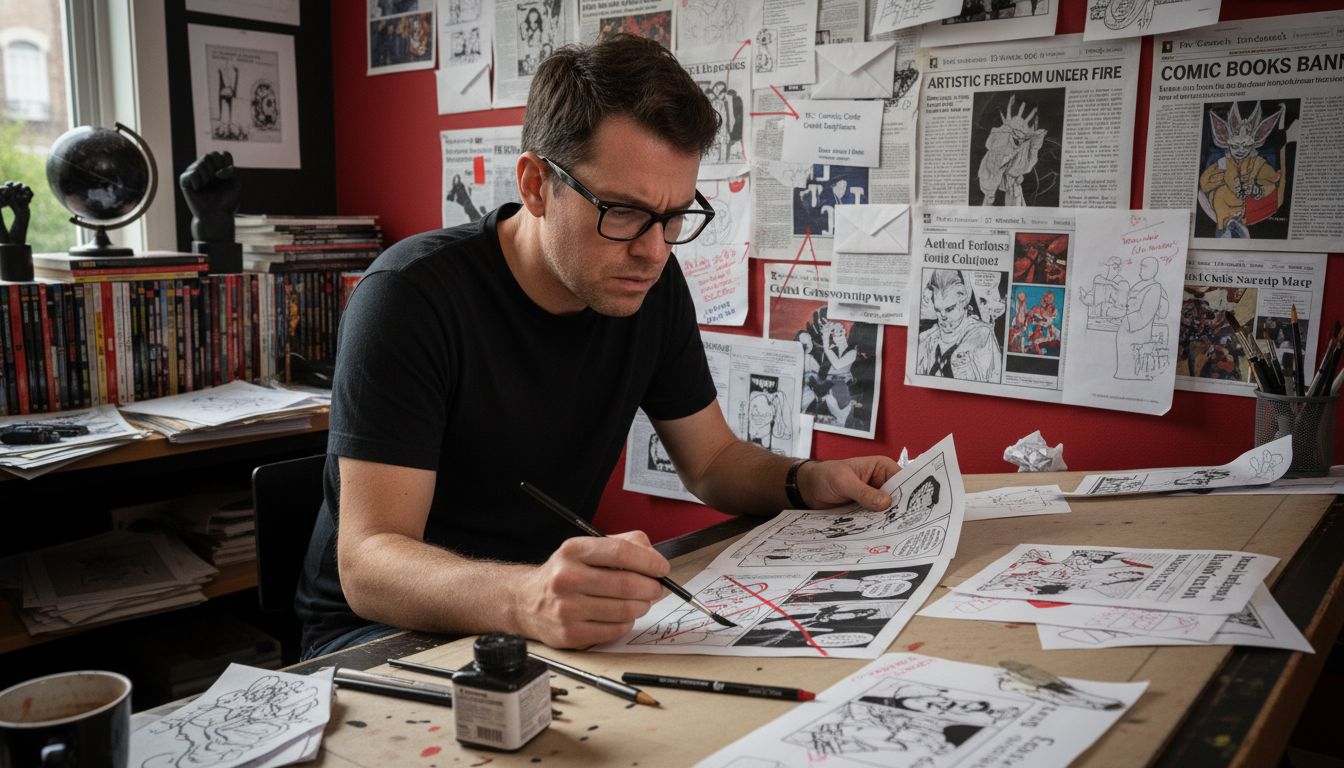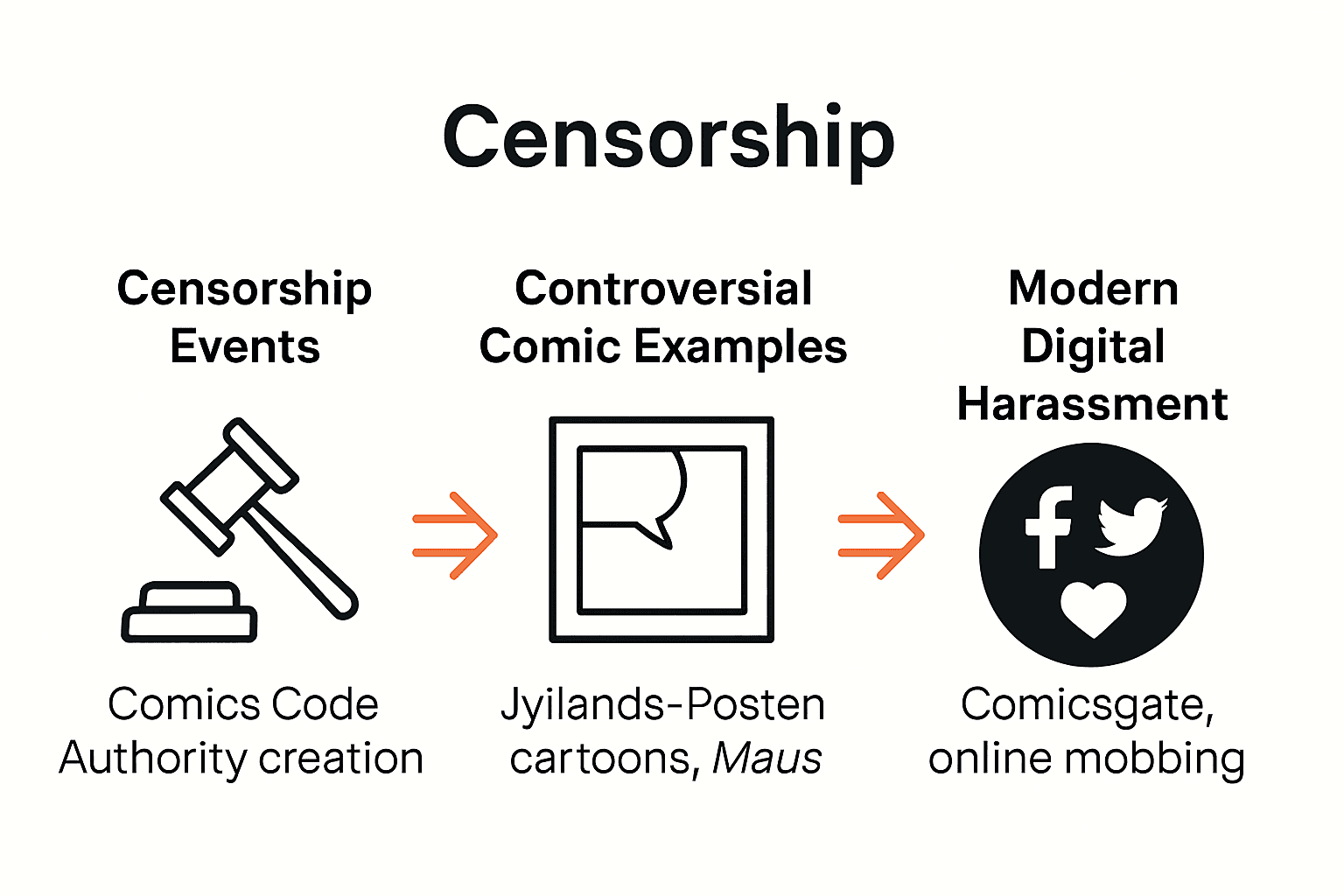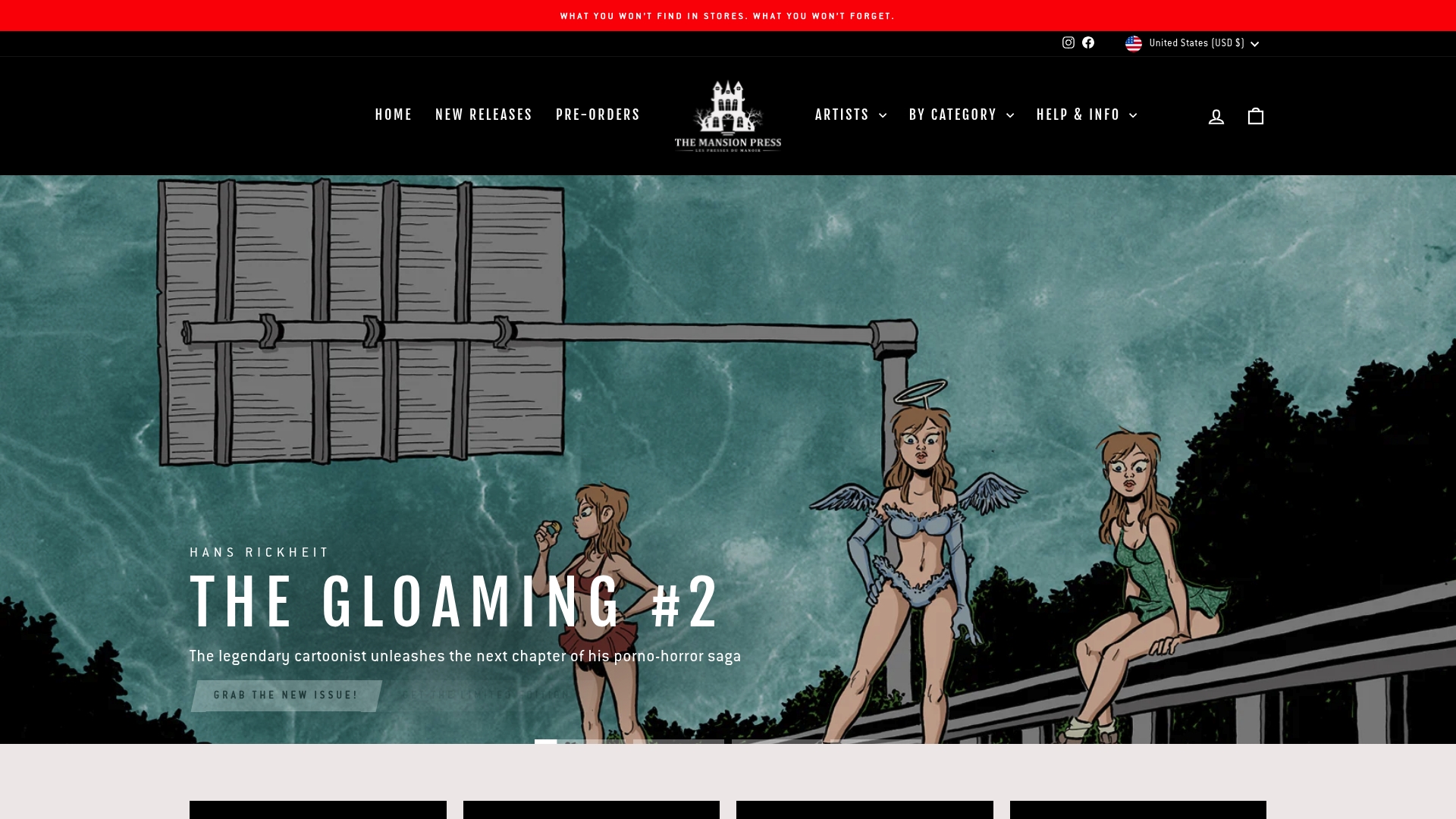Controversial Comics History: Everything You Should Know
Over 67 percent of banned books in schools and libraries are graphic novels or comics, highlighting just how controversial this storytelling format remains today. The history of comics is filled with heated debates about censorship, creative freedom, and social change. Exploring the roots and evolution of controversial comics reveals their unique power to question norms, inspire dialogue, and reshape how we see the world.
Table of Contents
- Defining Controversial Comics History
- Moral Panic And Censorship Origins
- Notable Controversial Comics Cases
- Industry Self‑Regulation And Pushback
- Modern Controversies And Online Harassment
Key Takeaways
| Point | Details |
|---|---|
| Impact of Censorship | The establishment of the Comics Code Authority in 1954 imposed strict content guidelines, significantly restricting creative freedom in comic storytelling. |
| Moral Panic Influence | Dr. Fredric Wertham’s campaign linked comics to juvenile delinquency, sparking moral panic that drastically influenced comic book regulation. |
| Modern Controversies | Digital harassment and ideological battles have intensified, reflecting ongoing tensions over representation and artistic expression in contemporary comics. |
| Challenging Norms | Controversial comics continue to question societal norms, serving as a vital medium for promoting discussions around censorship and creative autonomy. |
Defining Controversial Comics History
Controversial comics represent a powerful intersection between artistic expression and societal boundaries, challenging readers and sparking critical conversations about censorship, representation, and creative freedom. The history of these provocative works is deeply rooted in cultural tensions and ongoing debates about appropriate content in graphic storytelling.
According to research from the American Library Association, comic book controversies can be traced back to mid-20th century America, where educators and civic groups launched significant campaigns against perceived inappropriate content. A pivotal moment emerged with Dr. Fredric Wertham’s influential crusade against comics, which argued that these publications were harmful to youth and could potentially encourage antisocial behavior.
The industry’s response to these mounting pressures was the establishment of the Comics Code Authority in 1954, a self-regulatory body designed to sanitize comic book content and address public concerns. This regulatory mechanism imposed strict guidelines that fundamentally transformed comic book narratives, effectively limiting creative expression and diversity in storytelling. Comprehensive research indicates that these restrictions led to a significant decline in comic book sales and drastically reduced the range of available comic titles.
Key characteristics of controversial comics often include:
- Challenging social norms
- Graphic visual representations
- Provocative narrative themes
- Exploration of taboo subjects
- Political or social commentary
Understanding this complex history reveals how comics have consistently pushed artistic boundaries, transforming from supposedly “dangerous” media to respected narrative art forms. For those interested in diving deeper into this fascinating topic, check out our guide on banned comics in history.
Moral Panic And Censorship Origins
The emergence of moral panic in comic book history represents a critical turning point in understanding how societal fears can dramatically reshape artistic expression. In the post-World War II era, comics became a primary target for cultural criticism, transforming from popular entertainment to perceived threats to youth moral development.
According to research from the American Library Association, the most influential catalyst for comic book censorship was Dr. Fredric Wertham’s groundbreaking book ‘Seduction of the Innocent’. Wertham’s provocative arguments linked comic book content directly to juvenile delinquency, claiming that graphic narratives were indoctrinating young readers into antisocial behaviors. His campaign sparked widespread public hysteria and legislative hearings that would fundamentally alter the comics landscape.
The Wikipedia entry on media panic highlights how this phenomenon extended beyond comics, representing a broader societal mechanism of controlling potentially disruptive media. In response to mounting public pressure, the comic book industry established the Comics Code Authority in 1954, a self-regulatory body that imposed stringent content restrictions. These guidelines effectively neutered creative expression, mandating that comics avoid:

- Graphic violence
- Sexual innuendo
- Challenging social themes
- Depictions of criminal activities
- Controversial political commentary
For comic enthusiasts wanting to explore this fascinating censorship history in more depth, our article on understanding violent comics and controversy offers additional insights into this transformative period of graphic storytelling.
Notable Controversial Comics Cases
Controversial comics have long been a powerful medium for challenging societal norms and pushing artistic boundaries, often resulting in heated debates about freedom of expression and cultural sensitivity. These provocative works frequently become lightning rods for broader social conversations about censorship, representation, and the role of art in challenging established narratives.
One of the most internationally significant controversies emerged from the Jyllands-Posten Muhammad cartoons, as documented in Wikipedia’s examination of cartoons that shook the world. These cartoon depictions of the Prophet Muhammad sparked global protests, highlighting the complex intersection between artistic freedom and religious sensitivities. The incident demonstrated how comics could transcend mere entertainment and become potent tools for cultural dialogue and conflict.
More recently, Le Monde reported a fascinating case of contemporary comic book censorship involving cartoonist Jul’s adaptation of ‘Beauty and the Beast’. The French Education Ministry’s decision to cancel a mass printing of the comic, citing its unsuitability for children, reignited discussions about artistic autonomy and institutional control over creative expression.
Notable categories of controversial comics often include:
- Political satire
- Religious critique
- Sexual representation
- Historical reinterpretations
- Challenging social hierarchies
For comic enthusiasts eager to explore more provocative storytelling, our guide to provocative comics that inspire collectors offers deeper insights into these boundary-pushing narratives.
Industry Self‑Regulation And Pushback
The history of comic book regulation represents a complex battle between creative expression and societal expectations, with industry self-regulation emerging as a strategic response to mounting public pressure. Comic book publishers found themselves navigating a treacherous landscape of moral scrutiny and potential legal challenges throughout the mid-20th century.
According to Wikipedia’s entry on the Comics Code Authority, the comic book industry established a self-regulatory mechanism in 1954 to preempt external censorship. The Comics Code Authority (CCA) became a powerful internal watchdog, imposing strict guidelines that fundamentally transformed comic book content. Publishers who sought the CCA seal of approval were required to adhere to stringent content restrictions that effectively neutered creative storytelling.
The National Organization for Decent Literature further illuminates the broader cultural context of these regulatory efforts. This pressure group, active from 1938 to the late 1960s, represented a broader societal movement aimed at controlling literary and artistic expression. Their campaigns targeted not just comics, but a wide range of media they deemed inappropriate, creating a climate of cultural intimidation that forced creators to self-censor.
Key characteristics of this regulatory landscape included:
- Mandatory content review processes
- Strict moral standards
- Limitations on graphic content
- Suppression of controversial themes
- Systematic content sanitization
For comic enthusiasts interested in exploring the nuanced history of these regulatory battles, our guide to controversial comic book covers offers deeper insights into this transformative period of graphic storytelling.
Modern Controversies And Online Harassment
The digital age has transformed comic book controversies, introducing new dimensions of conflict that extend far beyond traditional censorship debates. Online harassment and ideological battles now play a significant role in shaping the contemporary comic book landscape, challenging creators and fundamentally altering industry dynamics.
Wikipedia’s entry on Comicsgate reveals a particularly stark example of these modern tensions. This alt-right harassment campaign emerged as a coordinated effort to oppose diversity and progressive representation in North American superhero comics. Targeting creators, especially women and creators of color, the movement represented a virulent backlash against attempts to broaden narrative perspectives and character representation in the comic book world.
The ongoing debates about comic book content take on new complexities in the digital era. As The Washington Post explores, works like ‘Maus’ continue to face censorship challenges, demonstrating that historical tensions around comic book content remain unresolved. These modern controversies often intersect with broader cultural conversations about representation, artistic freedom, and institutional power.
Key characteristics of modern comic book controversies include:

- Digital harassment campaigns
- Ideological content battles
- Attacks on creator diversity
- Online mobbing tactics
- Coordinated social media pressure
For comic enthusiasts interested in exploring provocative narratives, our guide to most provocative comics offers deeper insights into these complex contemporary dynamics.
Discover The Power Behind Controversial Comics and Own a Piece of History
Exploring the history of controversial comics reveals how these works challenge conventions and spark vital conversations about censorship, artistic freedom, and social change. If you are fascinated by bold storytelling that pushes boundaries and dives deep into provocative themes, why not bring that passion into your collection? At The Mansion Press, we connect you directly with exclusive artbooks, limited-edition comics, and original creations from independent artists who dare to explore these timely issues.

Dive into a curated selection that reflects the very struggles and triumphs described in the article, from provocative narratives to groundbreaking artwork. Visit The Mansion Press today to explore rare collector’s editions that capture the spirit of controversial comics history. Don’t miss your chance to own unique pieces that embody creative freedom while fueling your passion for art that matters.
Frequently Asked Questions
What are controversial comics?
Controversial comics are graphic narratives that challenge societal norms, often featuring provocative themes, graphic representations, and political or social commentary that can provoke strong reactions and discussions about censorship and representation.
What historical events influenced comic book censorship?
A pivotal moment in comic book censorship occurred in the mid-20th century with Dr. Fredric Wertham’s campaign against comics, leading to widespread concern over their impact on youth and the establishment of the Comics Code Authority in 1954, which imposed strict content guidelines on comic books.
How has the landscape of controversial comics changed in the digital age?
In the digital age, controversial comics face new challenges such as online harassment and ideological battles, with movements like Comicsgate opposing diversity and progressive representation in the comic book industry, thus altering the dynamics of creative expression and audience engagement.
What are some notable examples of controversial comics?
Notable examples of controversial comics include the Jyllands-Posten Muhammad cartoons, which sparked global protests, and works like ‘Maus’, which continue to face censorship debates, reflecting ongoing tensions surrounding artistic freedom and societal sensitivities.

